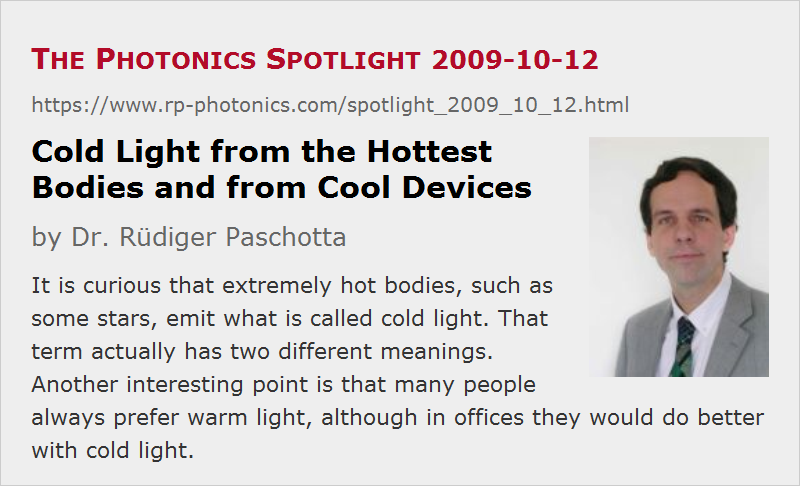Cold Light from the Hottest Bodies and from Cool Devices
Posted on 2009-10-12 as a part of the Photonics Spotlight (available as e-mail newsletter!)
Permanent link: https://www.rp-photonics.com/spotlight_2009_10_12.html
Author: Dr. Rüdiger Paschotta, RP Photonics Consulting GmbH
Abstract: It is curious that extremely hot bodies, such as some stars, emit what is called cold light. That term actually has two different meanings. Another interesting point is that many people always prefer warm light, although in offices they would do better with cold light.

Ref.: encyclopedia article on luminescence, light-emitting diodes and fluorescent lamps
The notion of “cold” and “warm” light is somewhat curious. “Warm” light colors are perceived when the red and orange parts are dominating the spectrum, whereas the blue part is weak. Such light is often thermal radiation from hot bodies, which may glow in red, orange or yellow. Warm light from hot bodies, that seems to make sense. However, what if some bodies get really hot? For example, some stars have surface temperatures well above 20,000 K, whereas our sun has somewhat less than 6,000 K. Such extremely hot stars have a bluish appearance, and such light is often called “cold” light. So the coldest light comes from the hottest bodies!
Another Meaning of “Cold Light”
Sometimes, “cold light” is meant to be light emitted from cold bodies – in other words, light not being thermal radiation. In many cases, it results from luminescence. For example, such luminescent light is emitted by fluorescent lamps and light-emitting diodes (LEDs). Such light sources do get somewhat warm, but they are definitely too cold for emitting visible thermal radiation. LEDs normally work best when kept as cool as possible. LEDs can emit white light – typically by converting some of the emitted blue light into light with longer wavelengths (e.g., in the yellow spectral region), sometimes by mixing the light from LEDs emitting red, green and blue light (see also: RGB sources). Often but not always, that white light has a somewhat bluish appearance, so that the term “cold light” applies with both mentioned meanings.
Prefer Warm or Cold Light?
“Warm” light is much more popular than “cold” light. For a living room, where you may want to relax in the evening, warm light is definitely more suitable. For your office, however, you will definitely do better with “cold” light, having a color balance which is closer to that of sun light at noon. (I am not claiming the spectrum is closer to that of sun light; what counts for the physiological effect is essentially the red–blue color balance, not the exact spectral shape.) Such “cold” light keeps you awake for a longer time, so it helps you to avoid the uncomfortable experience to be tired while having to work. Surely, there are many offices where people use “warm tone” fluorescent lamps, believing that this is better for them, although the result is that they suffer more than necessary from being tired. Well, there are offices where people may prefer to get sleepy, and in that case warm light will be perfectly appropriate.
See also the encyclopedia article on the term color temperature.
This article is a posting of the Photonics Spotlight, authored by Dr. Rüdiger Paschotta. You may link to this page and cite it, because its location is permanent. See also the RP Photonics Encyclopedia.
Note that you can also receive the articles in the form of a newsletter or with an RSS feed.
Questions and Comments from Users
Here you can submit questions and comments. As far as they get accepted by the author, they will appear above this paragraph together with the author’s answer. The author will decide on acceptance based on certain criteria. Essentially, the issue must be of sufficiently broad interest.
Please do not enter personal data here; we would otherwise delete it soon. (See also our privacy declaration.) If you wish to receive personal feedback or consultancy from the author, please contact him e.g. via e-mail.
By submitting the information, you give your consent to the potential publication of your inputs on our website according to our rules. (If you later retract your consent, we will delete those inputs.) As your inputs are first reviewed by the author, they may be published with some delay.
 |






If you like this page, please share the link with your friends and colleagues, e.g. via social media:
These sharing buttons are implemented in a privacy-friendly way!